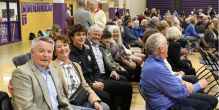Honoring the Legacy of Blessed BrotherJames Miller, FSC.
By Lou Anne Tighe, Campus Ministry
December 7, 2020
Lou Anne Tighe reflected on the life and beatification of Blessed Brother James Miller, FSC, for De La Salle magazine. He both studied and taught at Cretin High School. Today, our chapel is named after him and a bust is on prominent display, reminding us daily of his example.
On December 7, 2019, thousands gathered in Huehuetenango, Guatemala, for the beatification of Brother James “Santiago” Miller, FSC. Before this crowd of witnesses, Cardinal José Luis Lacunza Maestrojuán pronounced the Decree of Beatification from Pope Francis.
It was a profound declaration born of years of stories, testimonials, research and documentation. With singers and saxophone players, guitars, trap sets and tambourines, the atmosphere lifted the hearts of all assembled with gratitude and joy. In this experience, one could sense the wisdom of Pope Francis. He encouraged that beatifications take place not in Rome, but at the mission location of the beatified.
Among those who gathered were current students and faculty of the Colegio De La Salle, James’ sister and brother-in-law, Brothers, Partners, priests, bishops, archbishops, and cardinals. Perhaps the most revered guests were the Mayan people, that is, the faithful of Huehuetenango, who lived through the civil war. There were (now adult) students who were educated by the Brothers and families who had lost loved ones. Everyone present was moved with both tears and joy.
During the opening ceremony, Brothers Paul Joslin, Dale Mooney, Julio Herrera, and Juan Carlos Canales (president of Colegio De La Salle) carried the relic of Brother James on their shoulders to the altar. Brothers Paul and Dale, who lived in community with Brother James at the time of his death, were both solemn and filled with emotion. These men were not simply transporting a relic; they were carrying the memories of those days before, weeks after, and the 37 years since Brother James’ death.
On February 10, 1982, the Brothers in Huehuetenango heard from a reliable source that members of the G-2 (a section of the Guatemalan army rumored to be a “death squad”) were looking for the sub-director, a title held by Brother James for Casa Indígena De La Salle, the boarding school, and two other Brothers for Colegio De La Salle. The Brothers discussed what they should do: leave the country, move to a school in another part of Guatemala, or remain at Colegio De La Salle. After individual and community reflection they made the prayerful decision to stay with the 150 boys for as long as possible.
Brother James was a teacher, a steward of the earth, and an incredible handyman. Wrought iron lamps were affixed to the wall of Casa Indígena. These lamps provided an opportunity for some of the more “curious” boys to sneak out at night by swinging from the second floor to the street, which was very dangerous because young boys were being abducted into the army. On February 13, Brother James was removing a lamp and plastering the hole in the wall when he was killed.
His death was one of over 200,000 deaths of innocent victims in Guatemala. It was part of the violence and war that began in 1954 when the United States overthrew the democratically elected government. These facts and impressions help contextualize the martyrdom and beatification of Brother James Miller, and as profound and interesting as they might be, Brother James would not want this attention. He would prefer we look beyond him toward the people for whom he was willing to risk his life. In his heart, he felt called to work with the very poor, and to provide an education that would not only benefit them, but also potentially change an unjust social system. Cardinal José Luis had it right when he said: “There is nothing that bothers totalitarian regimes, of left or right, of yesterday or today, more than education.”
A Lasallian education has always meant more than imparting knowledge. A human and Christian education involves accompaniment and the development of the whole person: increasing one’s faith, serving others and forming the conscience for leadership in community. It is reminding students and one another that God is always present and that God will always provide grace, that is God’s Providence.
Inspired through, and yet looking beyond, the example of Blessed James, the option for the poor is clear. As Lasallians, the treatment of the lost, the least and the last remains a part of who we are. It is a defining mark of Catholic social teaching and the Lasallian educational legacy offered to the world. In every context of the educational ministry, those who are poor, however they are poor, come first.
Like Blessed James, as Lasallian Reflection 5 encourages us, “Our task is to keep our feet on the ground, to be in direct contact with those who suffer, to be in communion with those who want to change the world, and in dialogue with those who think differently. Only in this way will we have a deeper knowledge of reality and our answers be meaningful.” For we offer an education that earns a student more than a degree; ultimately they, like Blessed James and the martyrs of Central America, will “graduate” when they rise from the dead.
Reprinted with permission from De La Salle Today magazine.
Subscribe to our e-Newsletters
You might also like:
Two Brothers Earn Eagle Scout Rank, Continuing a Family Legacy
Isaac Andrzejek ’25 and Joseph Andrzejek ’27 have earned the rank of Eagle Scout, joining their three older brothers in achieving Scouting’s highest honor.
Grandparents Mass Welcomes Over 700 Guests
Cretin-Derham Hall’s annual Grandparents Mass welcomed over 700 guests for a celebration of faith and family.
Student Awards Ceremony Recognizes Outstanding Junior and Senior Students
Junior and senior students received well-deserved recognition at the Awards Assembly on Monday, April 28.




